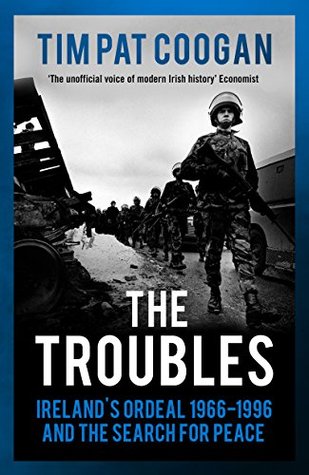More on this book
Kindle Notes & Highlights
Read between
May 28 - July 3, 2025
‘We factored in every possible eventuality except the possibility that the British would espouse the Unionist position.’ Cynics might have observed that given the history of Anglo-Irish relationships, that should have been regarded as the first possibility. But in the euphoria that surrounded the Downing Street Declaration, this had seemed unthinkable. However, as 1995 wore on it became more and more evident that this was what was happening.
even a symbolic gesture of de-commissioning IRA weapons in advance of talks would ‘symbolise an IRA surrender’.73 He accused Britain of ‘attempting to gain by stealth what it could not achieve in 25 years of military conflict’. The Sinn Fein position is that ‘de-commissioning’ should take place as a result of an all-party agreement on a total demilitarisation of the Six Counties. At the time of writing there were 130, 000 legally held weapons in Loyalist hands.74 In addition to these there were the countless thousands that either fell off, or did not get put on, lorries, at times such as the
...more
This highlight has been truncated due to consecutive passage length restrictions.
St Patrick’s Day in the White House was a night to remember. The roof almost lifted off to the sound of the cheers that greeted John Hume, when he broke off singing ‘The Town That I Loved So Well’ to say: ‘Come up here Gerry and join in.’ As the applause for the Hume and Adams duet died away, Bruce Morrison turned to Niall O’Dowd and asked: ‘Do you think the State Department will get the message now?’ It was truly a night in which Irish eyes were smiling. Nuns and priests, Loyalist paramilitary leaders, Cardinals and diplomats, the great and the good of America seemed to be saying that peace
...more
in places like East Tyrone, where, as in South Armagh and elsewhere, opposition to the ceasefire amongst Republicans was known to be strong, the security forces harrassed young men, as though peace had never come. Also, as if to stoke up the fires, members of the RIR (formally UDR) were quietly told to resume carrying their personal weapons in the anticipation of what Unionist spokesmen began referring to as a ‘rolling return’ to violence: in other words a planned, gradual return to full-scale hostilities throughout the Six Counties. On what intelligence those reports are based one can only
...more
This highlight has been truncated due to consecutive passage length restrictions.
For in the Catholic ghettoes, given the paratroopers’ record and the experience of the shoot-to-kill policy and all that had gone before, a very special significance had been attached to the Clegg affair. Just as when one enters the home of a hunter one can see at a glance from the trophies on the wall where his interests lie, so mural culture has traditionally expressed the strident emotions of the Six County streets. Although Tory spokespersons such as Lady Maitland flooded the TV screens to explain that the peace-keeping Clegg’s case was different from that of terrorist killers who
...more
Ken Maginnis, the official Unionist Party spokesman on Defence, tried to combat the idea with sarcasm. In an obvious reference to Sinn Fein he recalled that the Bosnian conference had excluded leaders suspected of war crimes, such as Radovan Karadic and General Maladic. However, Dublin wit speedily riposted that Maginnis need not worry, Sinn Fein had no objection to sitting down with him – despite the fact that he had been a member of the B-Specials and the UDR, both of which had been de-commissioned because of behaviour by some of their members which, to Sinn Fein eyes, sometimes amounted to
...more
In his Ard Fheis speech Adams had made his position regarding the Unionists quite clear: We want to make peace with you, we want to end the centuries-old conflict, we want to be reconciled with you; this is your country every bit as much as it is ours and we want to share it with you on a democratic and equal basis.
Thus, the 1991 returns are the first trustworthy figures for Northern Ireland’s population shifts to emerge in over twenty years. The figures shatter a number of cherished beliefs about the religious divide in the Six Counties. The classic assumption was that the population was divided in the ratio of two thirds Protestant to one third Catholic. In fact, the Catholics have risen to 43.1% of the population of 1, 577, 836 people. The much talked of ‘million Protestants’ are now below the 900, 000 mark and falling. These numbers are not so much affected by a larger Catholic birth rate, which has
...more


